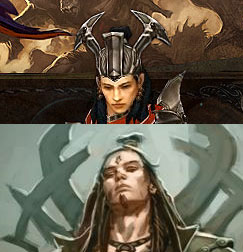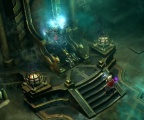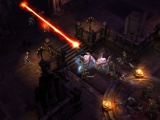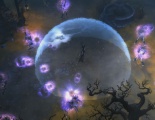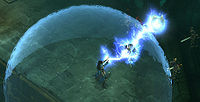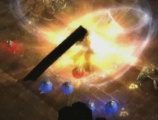Wizard
The Wizard is a pure spellcaster, harnessing arcane and elemental magic to do his/her bidding via a devastating array of offensive spells. While the Wizard is thought to be quite similar to the Sorcerer and Sorceress of previous Diablo games in design, the play style is quite different. Diablo 3's end game Wizard play puts a much greater emphasis on defensive skills and crowd control spells, and has much less movement speed due to the cooldown limitations on teleport.
Other major gameplay differences stem from equipment changes (weapon damage and Critical hit Chance / Critical hit Damage matter for all classes), the removal of skill points, and especially the fact that monsters do not have varying resistances to different types of elemental damage.
The resource system, Arcane Power differs greatly as well. AP refills very quickly, and Wizard skills use both AP cost and cooldown time as limiting factors. Both can be circumvented by other skills and item affixes. The "Arcane Power on Crit" ("APoC") affix is a build-changer for most end game wizards.
Contents
Class Design
| Diablo III Class | |
|---|---|
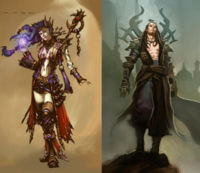
| |
| The Wizard | |
| Skills: | Wizard Skills |
| Passives: | Wizard Passives |
| Resource: | Arcane Power |
| Common builds: | |
| Caster, Battle mage. | |
|
| |
| Origin: | Xiansai |
| Affiliation: | None current. |
| Friends: | None known |
| Foes: | Vizjerei, Yshari Sanctum, Valthek |
The Wizard is a fast-action, fast-casting, primarily-ranged attacker. The class is not really a "glass cannon," despite having a Passive skill actuall called Glass Cannon. In fact, that is one of the main complaints about the class; that they are more of a mage tank than anything else, who must rely on defensive skills or strong crowd control and enemy debuffs to survive.
This is in stark contrast to the Sorcerer and Sorceress from previous games in the series, who could be a bit tanky with the right gear, but who mostly relied on speedy attacks and evasion (mostly via unlimited use of the Teleport skill). (The Demon Hunter actually plays much more like the glass cannon fast-movement mage seen in previous Diablo titles.)
See the Wizard skills page for a full list of all Wizard skills and rune effects. As with all classes, the skills are sorted into six categories. Enabling Elective Mode in the Game Options allows players to choose any skills from any category, rather than being stuck with one from each in the default, noob-friendly design.
- Refer to Diablo3Ladders.com for a listing of all Wizard passive skills ranked by popularity.
|
Primary |
Secondary |
Defensive |
|
Force |
Conjuration |
Mastery |
Wizard Passive Skills

See the Wizard passive skills article for a full listing with descriptions and more details. These skills focus more on utility, variety, and defense than on boosts to the Wizard's offensive attacks or damage.
|
|
By far the most used and most build-changing passive is Critical Mass which grants critical hits a chance to reduce the cooldown of Wizard skills by 1 second. Numerous Wizard builds rely entirely on "CM" in order to repeatedly use skills with 6, 8, 10 second, or even longer cooldowns. Blizzard has adjusted (lowered) the proc coefficient values of numerous Wizard skills several times since launch, since some skills (especially Energy Twister) that caused many, many hit checks were procing so often that Critical Mass was triggering almost constantly and effectively reducing cooldowns to nothing.
- Refer to Diablo3Ladders.com for a listing of all Wizard passive skills ranked by popularity.
Wizard Traits
During early design passive skills were called "traits" and were set to allow 1-5 points to be spent in each. This system was scrapped and simplified shortly before the beta test began. See the Wizard traits page for full info on what the traits system looked like.
Diablo 3 Wizard Lore and Story
Like all of the characters in Diablo 3, the Wizard has a unique in-game backstory that gives insight into the character's personality and mannerisms. The male and female versions of each class are essentially interchangeable in these non-gendered fictions.
The Diablo III Wizard hails from the far northern island of Xiansai, which lies in a region culturally and ethnically similar to Asia. The Wizards are anything but aged Dumbledore types; in the game fiction the Wizards (male and female) are portrayed as rebellious, impudent, headstrong, and cocky young mages who were too impatient to follow the rules and wait to learn slowly from the elders at the mage academy in Caldeum.
Abd al-Hazir, the scholar and historian responsible for most of the in-game lore released pre-game, wrote about the wizard's time in a mage academy in Caldeum in his seventh entry.
Although there is no truth to the tales that she actually ventured into the infamous Bitter Depths below the Sanctum, she was caught in the Ancient Repositories, where the most dangerous incantations are housed for the safety of the public. When confronted by the great Vizjerei mage Valthek and demanded to account for herself, she brazenly attacked him rather than face the punishment merited by her acts.
This story built fan expectations that the Wizard would be quite unruly and reckless. Unfortunately, those character traits do not really come through in the game, and even when the game action moves to Caldeum in Act Two, the Wizard does not show any concern or heightened attention in returning to that city.
Wizard Style and Appearance
The female wizard's appearance was widely-accepted and non-controversial. She looks quite a bit like her original concept art.
Male Wizard Controversy
The male wizard, on the other hand, had a very controversial reveal. No one thought much of his concept art or paid much attention to his appearance when he debuted as a playable character in the BlizzCon 2009 demo. However, some months later when Blizzard added his in-game model to their official wizard page, there was a curious eruption of fan rage. [1]
The primary complaints were that he looked too effeminate, and while there was arguably a homophobic edge to the complaints, the class design was more metrosexual and less masculine than some fans were expecting. People especially hated his "starfish" hat.
- Male Wizard gear set, October 13, 2010, set off the biggest debate of all, about his huge "starfish" hat.
- Many fan complaints and revisions of his starfish hat.
- And yet more fan remakes.
- A vote found very mixed opinions about the helm, in contrast to the overwhelmingly negative fan comments.
Blizzard made no substantive comments over the fan reaction to the male wizard's appearance and if the character changes any in appearance during the rest of the development cycle, no one noticed. A poll on Diablo.IncGamers.com found fan opinions widely split on the character's look.[2]
What do you think of the look of the Male Wizard?Total Votes: 844
- 2) It's good, but could be improved. 243 votes, 28.79%
- 4) Ugh. I'll be playing the female Wiz. 220 votes, 26.07%
- 5) Hate it. J-pop boy-band reject. 140 votes, 16.59%
- 1) I love the male Wizard look. 137 votes, 16.23%
- 3) I'm indifferent. M'eh. 104 votes, 12.32%
This entire controversy stemmed from the look of the character in some artwork and renders; no one objected to the look when playing him in the BlizzCon 2009 demo. That trend continued, and the controversy did not reappear when the beta test began and the look of the character is a non-issue post-release.
Sorceress Redux?
Some fans initially criticized the Wizard for just being the Sorceress with a new look. Jay Wilson commented on that in an interview with 1up.com in December 2008.
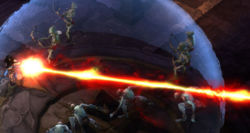
What we really wanted to do is break into this area, while if we just did the Sorceress again, we'd be like, "OK, you have to do fire, ice, and lightning, but where does Disintegrate fit? Where does Slow Time fit in?" So we decided [that we'd] just take the same class mechanics, and [that we'd] change the basic concept and name and just have a throwback to that old-school magic user to give ourselves a broader range of magic skills. But there was never a huge desire to go away from the basic gameplay of the Sorceress; there's a lot of repeated skills, and that's intentional."
Spell Damage and Weapon Damage
One major change from Diablo 2, seen during the development cycle, was the addition of spell damage item affixes. Unlike the skill point system in Diablo 1 and Diablo 2, Diablo 3 had no skill points, and thus weapon damage became as important for mages as for combat classes. The developers made this change partially to even out the classes, after the Sorceress and Necromancer were extremely good at Magic Find in Diablo 2 since they did not need to worry about boosting damage with equipment. (Just boosting skill level.) This allowed those characters to stack up much more Magic Find and Resistance on their gear, while still retaining a rapid killing speed.
The early effort in Diablo 3 to correct this imbalance used +%spell damage modifiers. As seen in Blizzcon 2008 and 2009 demos, caster weapons had bonuses to spell damage which modified the flat damage figures on spells, in much the same way that equipment and skills interacted for non-mage classes. A quote from a 2009 Blizzcon demo report details the system:
- When viewing the listed damage on each spell, it’s important to keep in mind that those are not absolute numbers, in D3. They’re much like weapon damage; modified by your wizard’s attributes, your character level, by other skills, and also by your equipment. Lots of types of items in D3 carry modifiers that boost spell damage, usually by a percentage.
- I found numerous wands, staves, and even pieces of armor with values between +5-25% spell damage, and that was just in the early stages of the game.
That system did not survive through to launch, and after further experimentation the Wizard and Witch Doctor were slotted into the same pool of affixes and weapon functions that the other three classes got. This made the game more accessible and consistent across the classes, but it's not a universally-popular design with many fans wishing the spell casters had different priorities in equipment and affixes than the combat characters.
Wizard Development Pace
The Wizard was the third class to be revealed, making her debut at BlizzCon 2008, several months after the game's initial reveal in June at the Paris WWI. Later in development Blizzard admitted that the Barbarian and Wizard were by far the most polished classes at launch. Despite that they chose to debut with the Barbarian and Witch Doctor since the WD was more of an original character type. This was a mixed blessing since many fans were unhappy that the Necromancer was not coming back, but when the Wizard debuted just months later, the class was clearly far more developed than the WD, with many more functional skills.
The Wizard's resource took longer to nail down. The class used Mana as a placeholder resource in the Blizzcon 2008 and 2009 demos, even after Blizzard had announced, in late 2009, that Mana was not going to be the final version of the class' resource. The system evolved further over the next couple of years, with Instability the resource for a time, until Arcane Power was implemented and perfected.[3]
Trivia
The female Wizard is voiced by Grey DeLisle, a veteran of voice acting. She's done many film and television roles, including Azula from Avatar: The Last Airbender, and roles in Afro Samurai, The Spectacular Spider-Man, Wolverine and the X-Men, and many more. She's also had many roles in video games, including a lot of the Star Wars series, Mass Effect, Metal Gear Solid, Baldur's Gate, Fallout, Doom 3, Batman: Arkham City (as Catwoman/Selina Kyle), and she also played Nova in StarCraft II.
The male Wizard is voiced by Crispin Freeman, also a veteran voice actor. He's done a gluttonous amount of English dubs for anime, and also many video games including the .hack series, BioShock 2, God of War III, Metal Gear Solid 4, Xenosaga, Saints Row: The Third, and many more.
Media
Wizard Profile Video
You can find pictures in the Diablo 3 screenshot and picture gallery:
Wizard vs King Leoric.
Wizard casting Disintegrate.
disintegrate used on Zombies.
Slow Time with Wave of Force to throw spells back at casters.
Casting Electrocute out of a Slow Time bubble.
Mana Globe in a level-up explosion.
Male Wizard concept by Glowei.
References
| Classes of the Diablo games |
Skills - Active skills - Skill runes - Passives - Resource - Movement ability [e] Barbarian Demon Hunter Monk Necromancer Witch Doctor Wizard Followers Other Classes Fan-made |
|---|
| The Barbarian | Fury - Barbarian Active Skills (Archive) | Barbarian Passive Skills (Archive) [e] | |||
|---|---|---|---|---|---|
|
|
Primary Might |
Secondary Tactics |
Defensive Rage |
Pound of Flesh (10) |
Superstition (30) |
| (X) = the level at which the skill becomes unlocked. | |||||
| Barbarian skill categories: Primary Secondary Defensive Might Tactics Rage |
|---|
|
Bash |
Cleave |
Frenzy |
[e] |
|
Hammer of the Ancients |
Rend |
Seismic Slam |
Whirlwind |
[e] |
|
Ground Stomp |
Leap |
Sprint |
Ignore Pain |
[e] |
|
Ancient Spear |
Revenge |
Furious Charge |
Overpower |
[e] |
|
Weapon Throw |
Threatening Shout |
Battle Rage |
War Cry |
[e] |
|
Earthquake |
Call of the Ancients |
Wrath of the Berserker |
[e] |
| The Demon Hunter | Hatred/Discipline - Demon Hunter Active Skills (Archive) | Demon Hunter Passive Skills (Archive) [e] | |||
|---|---|---|---|---|---|
|
Primary attribute:
|
Primary Hunting |
Secondary Devices |
Defensive Archery |
Tactical Advantage (10) |
Archery (30) |
| (X) = the level at which the skill becomes unlocked. | |||||
| Demon Hunter skill categories: Primary Secondary Defensive Hunting Devices Archery |
|---|
|
Hungering Arrow |
Entangling Shot |
Bola Shot |
Grenades |
[e] |
|
Impale |
Rapid Fire |
Chakram |
Elemental Arrow |
[e] |
|
Caltrops |
Smoke Screen |
Shadow Power |
[e] |
|
Vault |
Preparation |
Companion |
Marked for Death |
[e] |
|
Evasive Fire |
Fan of Knives |
Spike Trap |
Sentry |
[e] |
|
Strafe |
Multishot |
Cluster Arrow |
Rain of Vengeance |
[e] |
| Monk skill categories: Primary Secondary Defensive Techniques Focus Mantras |
|---|
|
Fists of Thunder |
Deadly Reach |
Crippling Wave |
Way of the Hundred Fists |
[e] |
|
Lashing Tail Kick |
Tempest Rush |
Wave of Light |
[e] |
|
Blinding Flash |
Breath of Heaven |
Serenity |
Inner Sanctuary |
[e] |
|
Dashing Strike |
Exploding Palm |
Sweeping Wind |
[e] |
|
Cyclone Strike |
Seven-Sided Strike |
Mystic Ally |
[e] |
|
Mantra of Evasion |
Mantra of Retribution |
Mantra of Healing |
Mantra of Conviction |
[e] |
| Necromancer skill categories: Primary Secondary Corpses Blood and Bone Reanimation Curses |
|---|
| Witch Doctor skill categories: Primary Secondary Defensive Terror Decay Voodoo |
|---|
|
Poison Dart - Rune effects |
Corpse Spiders |
Plague of Toads |
Firebomb |
[e] |
|
Grasp of the Dead |
Firebats |
Haunt |
Locust Swarm |
[e] |
|
Summon Zombie Dogs |
Horrify |
Spirit Walk |
Hex |
[e] |
|
Soul Harvest |
Sacrifice |
Mass Confusion |
[e] |
|
Zombie Charger |
Spirit Barrage |
Acid Cloud |
Wall of Zombies |
[e] |
|
Gargantuan |
Big Bad Voodoo |
Fetish Army |
[e] |
| The Wizard | Arcane Power - Wizard Active Skills (Archive) | Wizard Passive Skills (Archive) [e] | |||
|---|---|---|---|---|---|
|
Primary attribute:
|
Primary Force |
Secondary Conjuration |
Defensive Mastery |
Blur (10) |
Conflagration (34) |
| (X) = the level at which the skill becomes unlocked. | |||||
| Wizard skill categories: Primary Secondary Defensive Force Conjuration Mastery |
|---|
|
Magic Missile |
Shock Pulse |
Spectral Blade |
Electrocute |
[e] |
|
Ray of Frost |
Arcane Orb |
Arcane Torrent |
Disintegrate |
[e] |
|
Frost Nova |
Diamond Skin |
Slow Time |
Teleport |
[e] |
|
Wave of Force |
Energy Twister |
Hydra |
Meteor |
Blizzard |
[e] |
|
Ice Armor |
Storm Armor |
Magic Weapon |
Familiar |
Energy Armor |
[e] |
|
Explosive Blast |
Mirror Image |
Archon |
[e] |
| Followers | Kormac the Templar | Lyndon the Scoundrel | Eirena the Enchantress [e] | |||
|---|---|---|---|---|---|---|
|
Level 10: |
Level 5: Level 10: |
Level 15: |
Level 15: Level 20: |
Level 25: Level 30: | ||
| Diablo III Other Classes | Diablo II Classes | Diablo I Classes [e] | ||||
|---|---|---|---|---|---|---|
|
Archetypes: |
Archetype sub-types: |
Other classes: |
Diablo II: |
|||
| Fan-made Classes | Fan-made Skills [e] | ||||
|---|---|---|---|---|---|
|
• Alchemist |
• Flagellant |
• Ranger |
Dragon Warrior Skills |
Aurian Mage Skill | |
| | |||||

